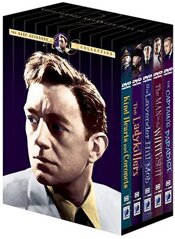I’ve just made some minor updates to a few reviews I wrote back in 2002. They’re all Alec Guinness movies (five of them), all done at Ealing Studios, and all come from an earlier part of the actor’s career. By the way, they’re all great.
The Alec Guinness Collection
Ealing Studios: 1949 – 1955

For some, Alec Guinness is the guy from Star Wars (Obi-Wan-Kenobi). For others, such as myself, he’s Colonel Nicholson from The Bridge on the River Kwai. But prior to these, and the many other dramatic roles he played brilliantly, Guinness was known as the comic genius of a series of British films made primarily in the 1950s at Ealing Studios. (They have their web site here.)
The Alec Guinness Collection from Anchor Bay brings together 5 of these films, all of them comic gems. (Update: This collection was brought out by Lion’s Gate in 2009 in the U.S. and Canada.)
What is interesting about these films is that Guinness’ performance isn’t that far removed from the kinds of performances he gave in dramatic roles. In other words, he knows that what makes these roles funny lies in playing them straight. It is the situation that makes the roles funny and the supporting casts, which are usually made up of character actors (often playing caricatures rather than characters).
The conceit informing most of the films is the secret life of a quiet, middle-class British man. Generally, the characters Guinness is playing are extremely British and a bit bookish perhaps. They are the sort of man no one would notice, for the most part, or, if noticed, be seen as very proper and respectable.

But each of these characters has a secret life they are living. Sometimes it’s criminal, like the caper in The Lavender Hill Mob; in the case of The Captain’s Paradise, it’s an adulterous relationship. Also in common is the secret life these small, quiet men dream of.
That is at the core of the films — the fantasies of the domesticated, perhaps even socially emasculated, male. The humour comes out of the collision between the reality and the fantasy. It develops out of the character’s attempts to hold on to his fantasy.
In most of the films, the Guinness character ends up facing a comeuppance, the triumph of reality over fantasy. However, this doesn’t always mean the character loses. In fact, even when he does lose there is something in the way the ending is handled that makes us feel he has somehow won.
Brevity and excellent pacing also characterize the films. This, combined with Guinness’ flawless performances, makes the movies work.
The Alec Guinness Collection:
- Kind Hearts & Coronets
- Lavender Hill Mob
- The Man in the White Suit
- The Captain’s Paradise
- The Ladykillers
Links:
- The Alec Guinness Collection on Amazon


